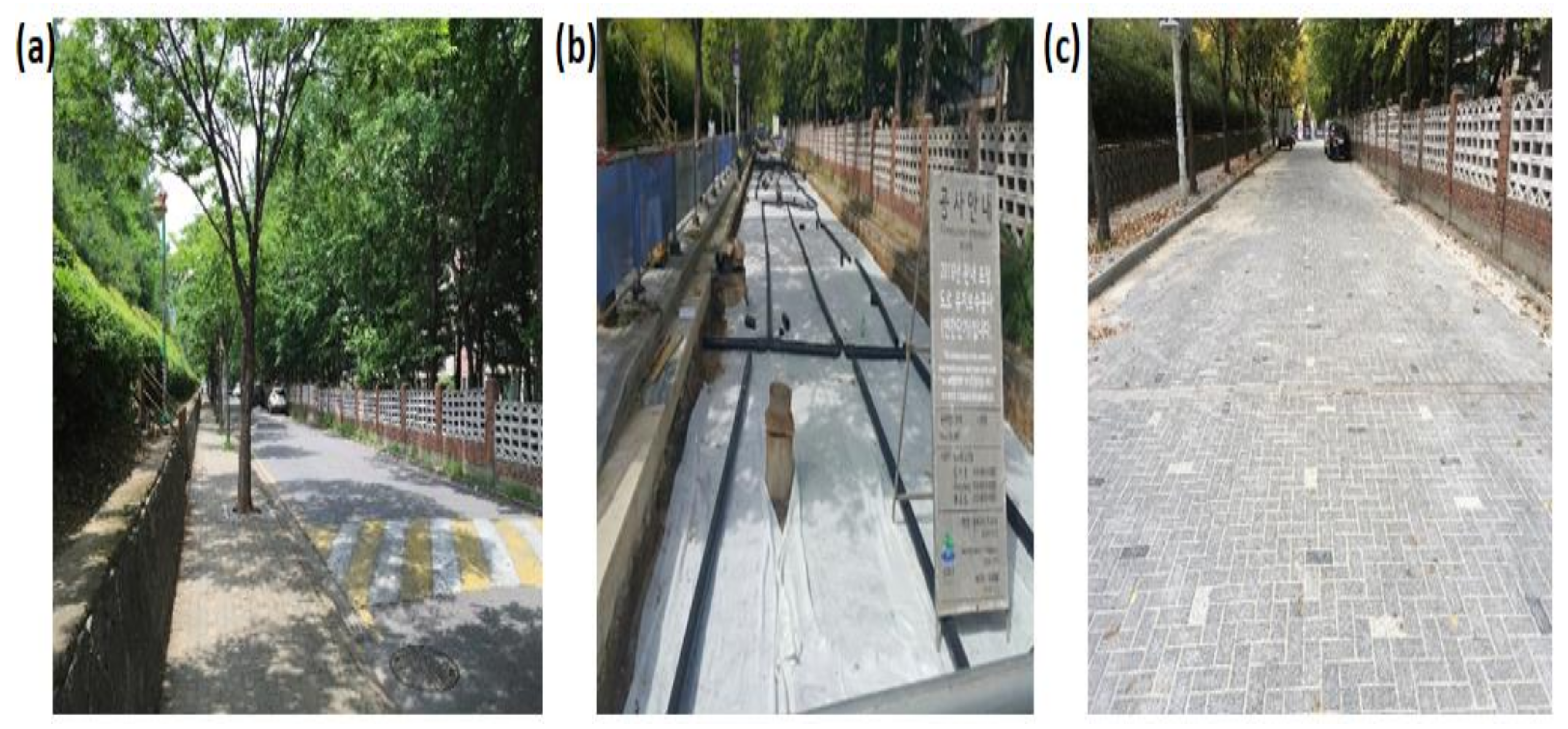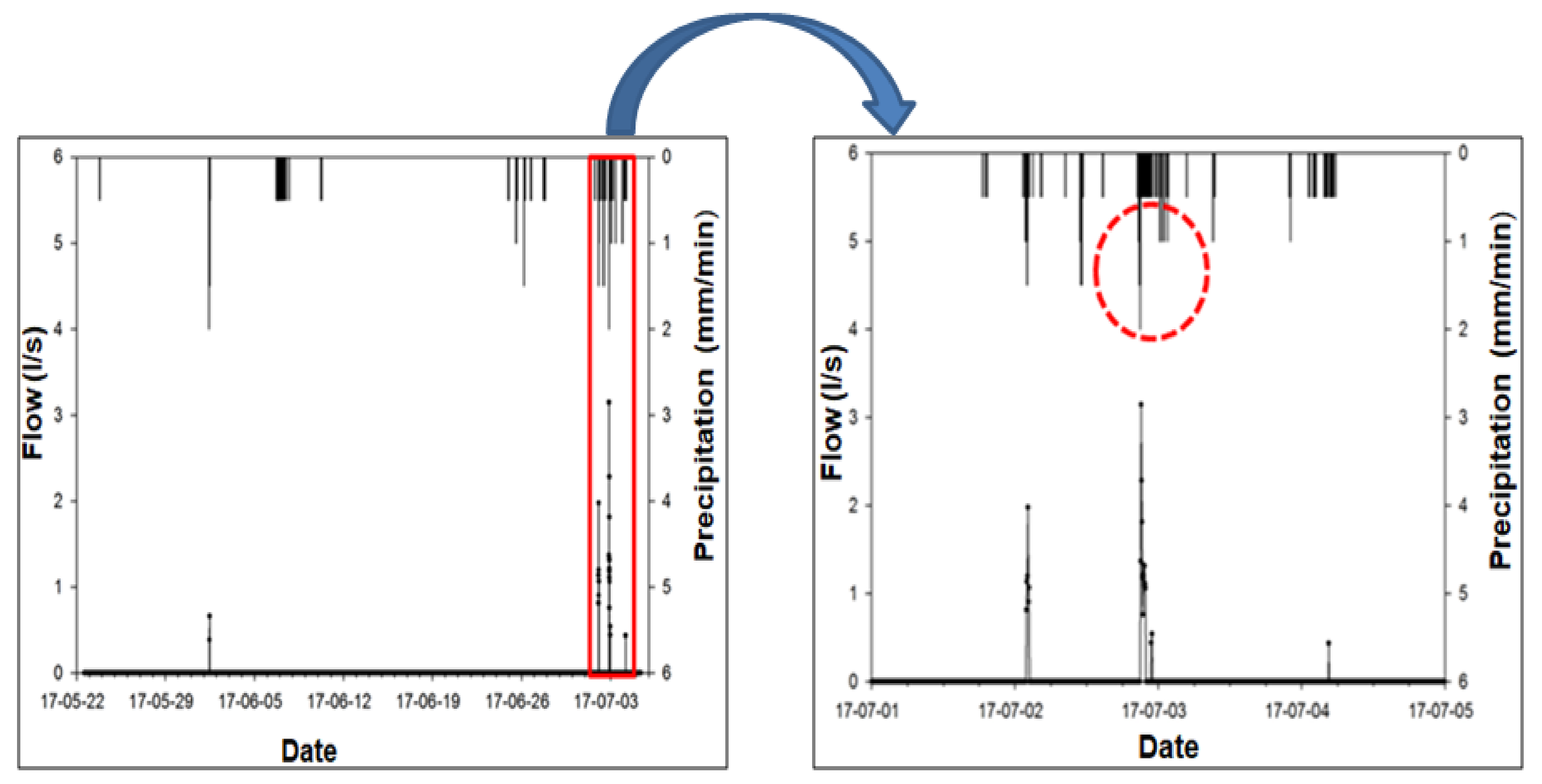Rainfall Runoff Mitigation by Retrofitted Permeable Pavement in an Urban Area
Abstract
:1. Introduction
2. Materials and Methods
2.1. Site Detail Description
2.2. Monitoring and Data Calculation
3. Results and Discussion
Runoff Reduction Performance of PICP System
4. Concluding Remarks
- (1)
- Permeable interlocking concrete pavement showed the tremendous performance in controlling a large amount of rainfall runoff in urban areas. The overall runoff volume reduction was around 30–65% during various storm events. This not only decreases the rainfall runoff volume, but also the peak flow discharge which is very helpful in lowering flash flooding in urban areas.
- (2)
- The hydrological performance of the PICP system was enormously influenced by the type of underlying native soil. This is because the native soil has higher infiltration rates and is thus capable of absorbing a large amount rainfall runoff. Because of this, it prevents the ponding on the surface of the pavement.
Acknowledgments
Author Contributions
Conflicts of Interest
References
- Franczyk, J.; Chang, H. The effects of climate change and urbanization on the runoff of the rock creek basin in the Portland Metropolitan Area, Oregon, USA. Hydrol. Process. 2009, 23, 805–815. [Google Scholar] [CrossRef]
- Booth, D.; Hartley, D.; Jackson, R. Forest cover, impervious surface area, and the mitigation of storm-water impacts. J. Am. Water Resour. Assoc. 2002, 38, 835–845. [Google Scholar] [CrossRef]
- Line, D.; White, N. Effects of development on runoff and pollutant export. Water Environ. Res. 2007, 79, 185–190. [Google Scholar] [CrossRef] [PubMed]
- Moglen, G. Hydrology and impervious areas. J. Hydrol. Eng. 2009, 14, 303–304. [Google Scholar] [CrossRef]
- Todeschini, S. Hydrologic and environmental impacts of imperviousness in an industrial catchment of Northern Italy. J. Hydrol. Eng. 2016. [Google Scholar] [CrossRef]
- Shafique, M.; Kim, R. Recent Progress in Low-Impact Development in South Korea: Water-Management Policies, Challenges and Opportunities. Water 2018, 10, 435. [Google Scholar] [CrossRef]
- Pratt, C.J.; Wilson, S.; Cooper, P. Source control using constructed pervious pavements. In Hydraulic, Structural and Water Quality Performance Issues; CIRIA: London, UK, 2002. [Google Scholar]
- Bean, E.Z.; Hunt, W.F.; Bidelspach, D.A. Evaluation of four permeable pavement sites in eastern North Carolina for runoff reduction and water quality impacts. J. Irrig. Drain. Eng. 2007, 133, 583–592. [Google Scholar] [CrossRef]
- Brattebo, B.O.; Booth, D.B. Long-term stormwater quantity and quality performance of permeable pavement systems. Water Res. 2003, 37, 4369–4376. [Google Scholar] [CrossRef]
- Scholz, M.; Grabowiecki, P. Review of permeable pavement systems. Build. Environ. 2007, 42, 3830–3836. [Google Scholar] [CrossRef]
- Ahiablame, L.; Engel, B.; Chaubey, I. Effectiveness of low impact development practices: Literature review and suggestions for future research. Water Air Soil Pollut. 2012, 223, 4253–4273. [Google Scholar] [CrossRef]
- Shafique, M.; Kim, R. Green stormwater infrastructure with low impact development concept: A review of current research. Desalination Water Treat. 2017, 83, 16–29. [Google Scholar] [CrossRef]
- Dreelin, E.A.; Fowler, L.; Carroll, C.R. A test of porous pavement effectiveness on clay soils during natural storm events. Water Res. 2006, 40, 799–805. [Google Scholar] [CrossRef] [PubMed]
- Park, S.B.; Tia, M. An experimental study on the water purification properties of porous concrete. Cement Concr. Res. 2004, 34, 177–184. [Google Scholar] [CrossRef]
- Bernot, M.J.; Calkins, M.; Bernot, R.J.; Hunt, M. The influence of different urban pavements on water chemistry. Road Mater. Pav. Des. 2011, 12, 159–176. [Google Scholar] [CrossRef]
- Collins, K.A.; Hunt, W.F.; Hathaway, J.M. Hydrologic comparison of four types of permeable pavement and standard asphalt in Eastern North Carolina. J. Hydrol. Eng. 2008, 13, 1146–1157. [Google Scholar] [CrossRef]
- Palla, A.; Gnecco, I.; Carbone, M.; Garofalo, G.; Lanza, L.; Piro, P. Influence of stratigraphy and slope on the drainage capacity of permeable pavements: Laboratory results. Urban Water J. 2015, 12, 394–403. [Google Scholar] [CrossRef]
- Drake, J. Performance and Operation of Partial Infiltration Permeable Pavement Systems in the Ontario Climate. Ph.D. Thesis, University of Guelph, Guelph, ON, Canada, 2013. [Google Scholar]
- Gilbert, J.K.; Clausen, J.C. Stormwater runoff quality and quantity from asphalt, paver, and crushed stone driveways in Connecticut. Water Res. 2006, 40, 826–832. [Google Scholar] [CrossRef] [PubMed]
- Huang, J.J.; Li, Y.; Niu, S.; Zhou, S.H. Assessing the performances of low impact development alternatives by long-term simulation for a semi-arid area in Tianjin, northern China. Water Sci. Technol. 2014, 70, 1740–1745. [Google Scholar] [CrossRef] [PubMed]
- Xie, J.; Wu, C.; Li, H.; Chen, G. Study on storm-water management of grassed swales and permeable pavement based on SWMM. Water 2017, 9. [Google Scholar] [CrossRef]
- Kumar, K.; Kozak, J.; Hundal, L.; Cox, A.; Zhang, H.; Granato, T. In-situ infiltration performance of different permeable pavements in a employee used parking lot—A four-year study. J. Environ. Manag. 2016, 167, 8–14. [Google Scholar] [CrossRef] [PubMed]
- Gao, M.; Carmichael, G.R.; Saide, P.E.; Lu, Z.; Yu, M.; Streets, D.G.; Wang, Z. Response of winter fine particulate matter concentrations to emission and meteorology changes in North China. Atmos. Chem. Phys. 2016, 16, 11837–11851. [Google Scholar] [CrossRef]
- Razzaghmanesh, M.; Beecham, S. A review of permeable pavement clogging investigations and recommended maintenance regimes. Water 2018, 10. [Google Scholar] [CrossRef]
- Korea Meteorological Administration (KMA) 2018. Available online: http://web.kma.go.kr/eng/weather/climate/worldclimate.jsp (accessed on 19 January 2018).
- Braswell, A.S.; Anderson, A.R.; Hunt, W.F. Hydrologic and water quality evaluation of a permeable pavement and biofiltration device in series. Water 2018, 10. [Google Scholar] [CrossRef]








| Parameter | PICP System |
|---|---|
| PICP total drainage area | Around 200 (m2) |
| Hydraulic conductivity of sub-grade soil | 6.5 (mm/s) |
| Watershed land use | Residential and asphalt pavement |
| Drainage area: PICP area | 3:1 |
| Underlying soil classification | Sandy loam |
| Rainfall intensity | 30–120 (mm/h) |
| PICP system length | 20 m |
| PICP system width | 7 m |
| Monitoring period | 22 April 2017–16 July 2017 |
| Rainfall Events | Runoff Volume Reduction Performance |
|---|---|
| Rainfall intensity: 40 (mm/h) | 100% |
| Rainfall intensity: 120 (mm/h) | 30–50% |
| All storm events | Around 30–65% |
© 2018 by the authors. Licensee MDPI, Basel, Switzerland. This article is an open access article distributed under the terms and conditions of the Creative Commons Attribution (CC BY) license (http://creativecommons.org/licenses/by/4.0/).
Share and Cite
Shafique, M.; Kim, R.; Kyung-Ho, K. Rainfall Runoff Mitigation by Retrofitted Permeable Pavement in an Urban Area. Sustainability 2018, 10, 1231. https://doi.org/10.3390/su10041231
Shafique M, Kim R, Kyung-Ho K. Rainfall Runoff Mitigation by Retrofitted Permeable Pavement in an Urban Area. Sustainability. 2018; 10(4):1231. https://doi.org/10.3390/su10041231
Chicago/Turabian StyleShafique, Muhammad, Reeho Kim, and Kwon Kyung-Ho. 2018. "Rainfall Runoff Mitigation by Retrofitted Permeable Pavement in an Urban Area" Sustainability 10, no. 4: 1231. https://doi.org/10.3390/su10041231
APA StyleShafique, M., Kim, R., & Kyung-Ho, K. (2018). Rainfall Runoff Mitigation by Retrofitted Permeable Pavement in an Urban Area. Sustainability, 10(4), 1231. https://doi.org/10.3390/su10041231






